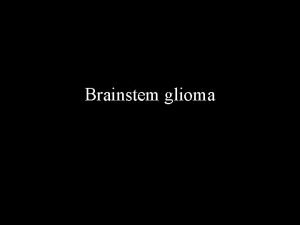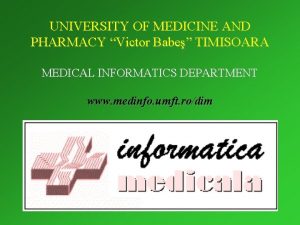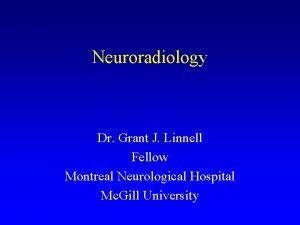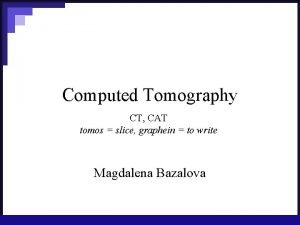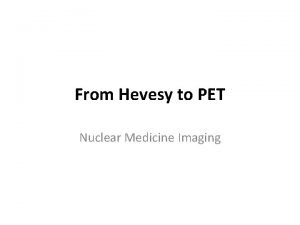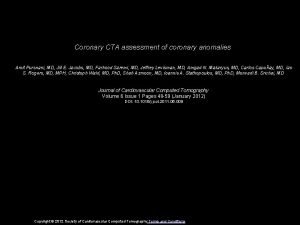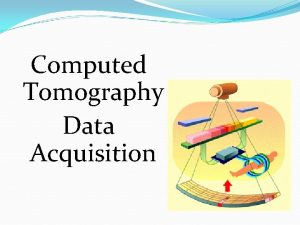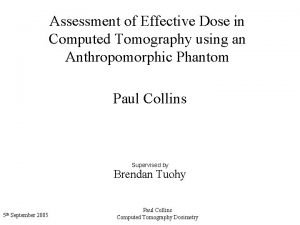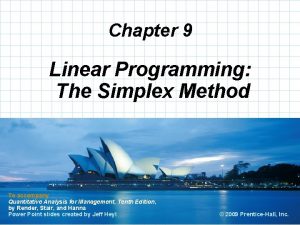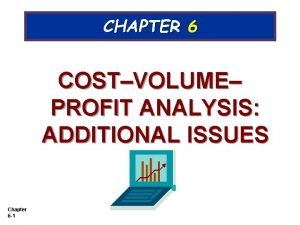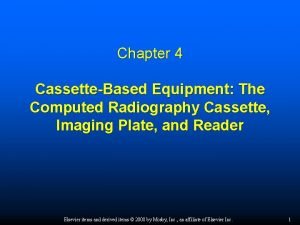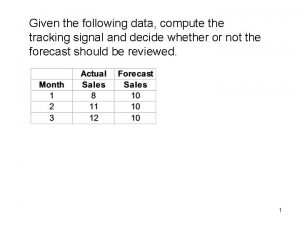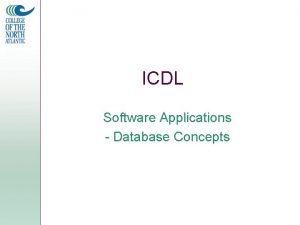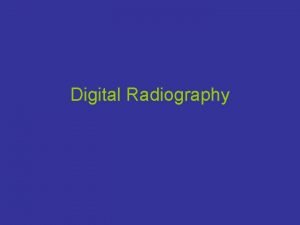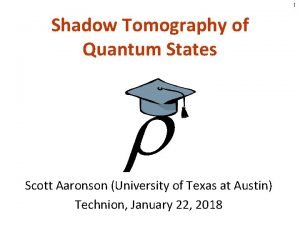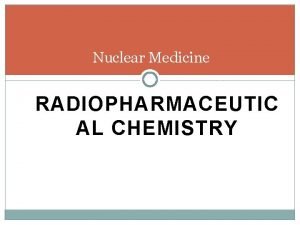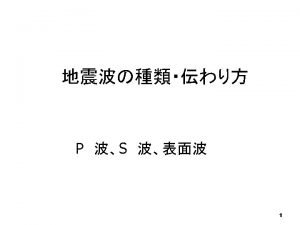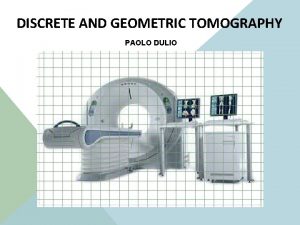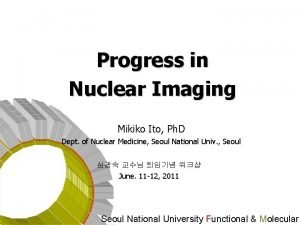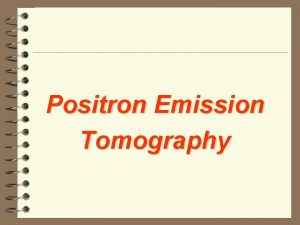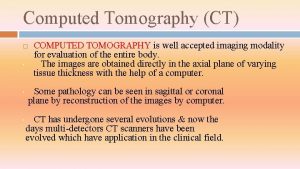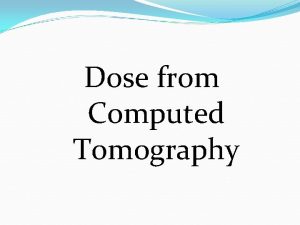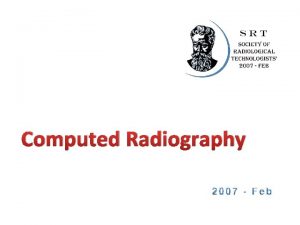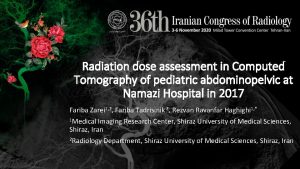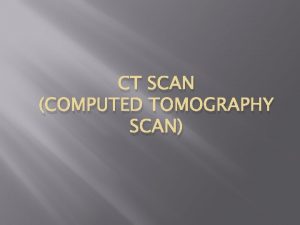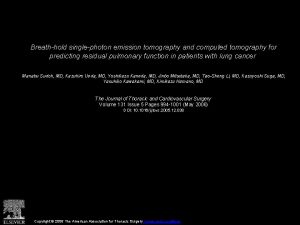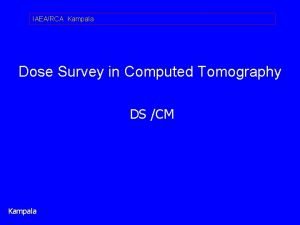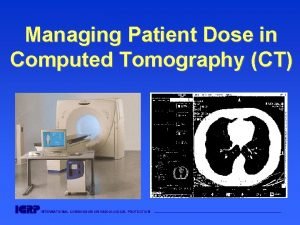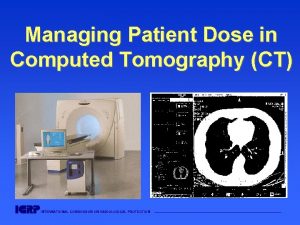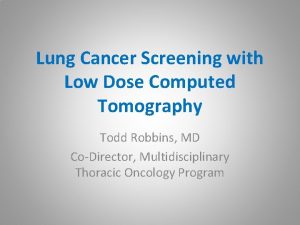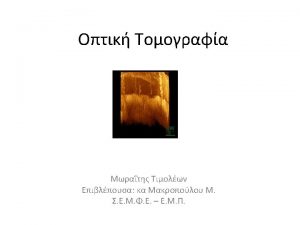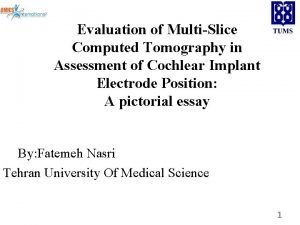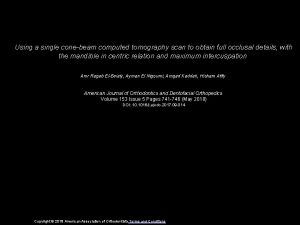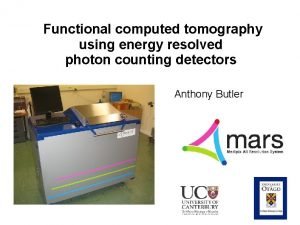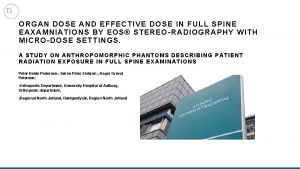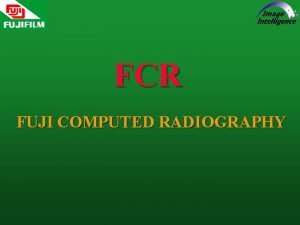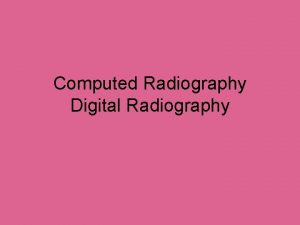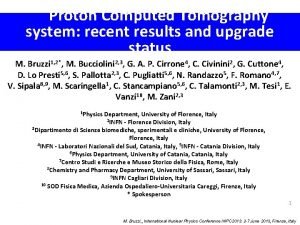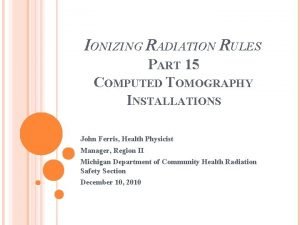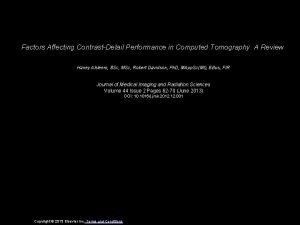Assessment of Effective Dose in Computed Tomography using






















- Slides: 22

Assessment of Effective Dose in Computed Tomography using an Anthropomorphic Phantom Paul Collins Supervised by Brendan Tuohy 5 th September 2005 Paul Collins Computed Tomography Dosimetry

Overview • Motivation and Objectives • Methodology • Organ Location in Phantom and Measurement • Patient ‘Effective Dose’ Calculation • Results • Conclusions 5 th September 2005 Paul Collins Computed Tomography Dosimetry

Motivation Investigate the rise of patient dose in CT • Indications are that patient dose is rising in CT • Due to evolution of CT technology and subsequent changes in practise • Conventional CT has now evolved to Multi-Slice CT (MSCT) which has to potential to vastly increase dose Objectives • Evaluate changes in patient dose due to advancement of MSCT scanners 5 th September 2005 Paul Collins Computed Tomography Dosimetry

What is MSCT Siemens, 2004 SSCT MSCT (Single Slice CT) (Multi-Slice CT) • Evolved from development of the Detector Array • 64 Slice CT : 1 rotation = up to 64 Slice acquisition 5 th September 2005 Paul Collins Computed Tomography Dosimetry

Why MSCT • Benefits • Disadvantages – Near Isotropic – Fast Imaging – Increase Data • . 33 sec Rotation Times – High Quality Images – Thinner Slices – Large Volume Acquisition • Staff Workload • Data Storage – Increase in Patient Dose • Technology Changes • Changes in practise 0. 6 mm Slice thickness 6 sec scan time Siemens 64 Slice Scanner, 2004 5 th September 2005 Paul Collins Computed Tomography Dosimetry

Why Patient Dose is increasing • Technology Changes – Extra volume scanned – Extra helical rotations – Interpolation for axial reconstruction – Z-axis over beaming • Protocol Changes –May be tendency to image more volume –Thinner Slices –Higher quality – Penumbra region not utilised by detectors 5 th September 2005 Paul Collins Computed Tomography Dosimetry

Why slices thickness affects patient dose? – Image noise is random fluctuations of pixels values – Finite number of x-ray photons are transmitted (i. e. in a slice) – Thinner slices Less x-ray photons larger variation in pixel values more noise – m. A then has to be increased to provide useful diagnostic images – linear relationship between m. A and patient dose 5 th September 2005 Paul Collins Computed Tomography Dosimetry

Evaluation of patient dose 1. Randoman aka ‘Séamus’ – Tissue Equivalent Humanoid Phantom – Verified for measurement of absorbed dose in CT – 35 axial slices – Plugs to hold TLDs 2. Diagnostic TLDs – Measure Absorbed dose to Organs – ~45 TLD were placed at specific organ locations for each protocol – Organ selection and patient dose calculation guided by ICRP publication 60 (International Commission on Radiation Protection) 5 th September 2005 Paul Collins Computed Tomography Dosimetry

Organ Location • TLDs needed to be placed accurately within phantom to measure organ dose • Methodology – Whole Body CT of Phantom – Calibrated Image using Image. J software tool • Any point to point distance know – Labelled Vertebral Column • Could now relate each slice of phantom to specific vertebra – Human Slice Server used to locate organs according to vertebral column 5 th September 2005 Human Slice Server Sagittal view Paul Collins Computed Tomography Dosimetry Whole Body Phantom CT

Organ Location • Human Slice Server –virtual reconstruction of human anatomy in any orientation or location – 3 D datasets from a human body Human Slice Image ( T-11 ) • frozen & digitised into 1 mm slices –Labelled images of organs/tissues/vertebrae etc. –Organs were then located in phantom using the vertebrae as a guide 5 th September 2005 Paul Collins Computed Tomography Dosimetry Slice 22 of phantom

Human Slice Server Screen Capture 5 th September 2005 Paul Collins Computed Tomography Dosimetry

Organ Selection • Organs selected to allow for effective dose measurement – ICRP 60 • Organs were located using previous method • At least two TLDs placed within each organ e. g. – #2 TLDs in gonads – #6 TLDs in lung 5 th September 2005 Paul Collins Computed Tomography Dosimetry

Effective Dose • Effective Dose Calculation – Sum of weighted equivalent doses in tissues and organs E: Effective Dose (Sievert) WT: Tissue weighting Factor HT : Equivalent Dose (Sievert) T: Tissue/Organ HT = Absorbed Dose x Radiation Factor The remainder is composed of the following tissues and organs: adrenal, brain, upper large intestine, small intestine, kidney, muscle, pancreas, spleen, thymus and uterus. Radiation factor for photons 1 5 th September 2005 Paul Collins Computed Tomography Dosimetry

Protocols • Standard Imaging Protocols – – Abdomen/Pelvis Head Chest RT protocols (Radiotherapy) 5 th September 2005 • CT Scanners – Philips ACQSim (RT scanner) – Siemens Sensation Emotion Duo – Siemens Sensation Emotion 6 – Philips Brilliance 16 Paul Collins Computed Tomography Dosimetry

Abdomen/Pelvis Protocol Effective m. As = m. As/pitch 5 th September 2005 ß Slice thickness ß Scan Time Paul Collins Computed Tomography Dosimetry

Organ Absorbed Dose • Increases in average dose to organs located in primary radiation beam • Highest absorbed doses to – Skin – Bone Marrow – Colon – Gonads – Oesophagus 5 th September 2005 Paul Collins Computed Tomography Dosimetry

Abdomen/Pelvis Protocol 5 th September 2005 Paul Collins Computed Tomography Dosimetry

Other Protocols Head Protocol • Axial imaging • Skin dose – 32. 80 m. Gy • m. As 260 m. As to 350 m. As • Brain dose – 30. 52 m. Gy Radiotherapy Protocols • Axial imaging 5 th September 2005 • 3 mm Slices Paul Collins Computed Tomography Dosimetry

Radiation Risks • Risks from Effective dose (ICRP 60) • 1 m. Sv equates to a cancer risk of 1 in 20000 Abdomen/Pelvis Protocol • 1 in 4000 risk for 5 m. Sv • 1 in 2500 risk for 8 m. Sv • 1 in 2000 risk for 10 m. Sv 5 th September 2005 Paul Collins Computed Tomography Dosimetry

Conclusions • Dose is increasing • 64 slice scanner UCHG – 0. 33 sec rotation 0. 6 mm slice thickness • Effective dose of 64 Slice scanner? 5 th September 2005 Paul Collins Computed Tomography Dosimetry

Conclusions Image Quality Patient Dose • Patient dose generally increases with better image quality • Diagnosis is the goal of CT • Is patient diagnosis improving with increasing patient dose? • Does greater image quality result in better diagnosis? • ALARA principle –Does diagnosis improve from 2 Slice to 6 Slice to 16 Slice? 5 th September 2005 Paul Collins Computed Tomography Dosimetry

Questions? Toshiba 256 detector 4 D-CT scanner 5 th September 2005 Paul Collins Computed Tomography Dosimetry
 Chodorma
Chodorma Radiology timisoara
Radiology timisoara Hematome
Hematome 4th generation of ct scan
4th generation of ct scan Computed tomography
Computed tomography Journal of cardiovascular computed tomography
Journal of cardiovascular computed tomography Ct data acquisition system
Ct data acquisition system Effective dose
Effective dose Effective dose
Effective dose What cj-zj represents
What cj-zj represents Margin of safety in dollars
Margin of safety in dollars The cr cassette is backed by aluminum that
The cr cassette is backed by aluminum that Tracking signal definition
Tracking signal definition A computed is a calculation that a dbms performs
A computed is a calculation that a dbms performs What is computed radiography
What is computed radiography Shadow tomography
Shadow tomography Seismic tomography ______.
Seismic tomography ______. Positron emission tomography
Positron emission tomography Positron emission tomography
Positron emission tomography Seismic tomography
Seismic tomography Paolo dulio
Paolo dulio Positron emission tomography
Positron emission tomography Positron emission tomography
Positron emission tomography
